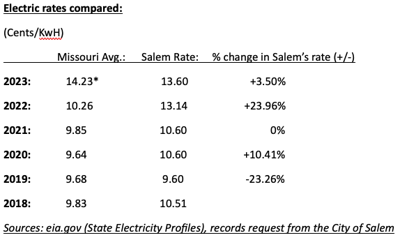The rising cost of power is an issue that has loomed over the minds of many Missourians over the last few years. Economic factors that drive electric rates have caused increases across the board. According to the U.S. Energy Information Administration (eia.gov), the average retail price for electricity in Missouri was 10.26 cents/KwH in 2022, up from an average of 9.85 cents/KwH in 2021, and 9.64 cents/KwH in 2020. In Salem, the rate has risen from a low of 9.60 cents/KwH in 2019 to 13.60 cents/KwH in 2023.
Several rapid-fire events forced the rate up, according to alderman Kyle Williams, who is the chairman and a non-voting member of the city’s Utility Committee, the purpose of which is to make recommendations regarding city utilities (including rate changes) to the Board of Aldermen. Though several rate increases (including one of almost 24% in 2022) have happened over the past several years, Williams says he sees the rate stabilizing going forward.
According to Williams, the rate had not been kept concurrent with costs for several years by previous city government, and the electric utility was being kept afloat by American Rescue Plan Act (ARPA) funds, or in other words, federal COVID money, which ended at the beginning of the current budget year. He said that some of the increases over past years had to do with getting the rate back on track with costs as the ARPA money ended, but there were other aspects of the utility business that drive increases in costs as well.
City administrator Sally Burbridge told The Salem News that the events of 2020 and 2021 likely prompted the city to jump the electric rates, though she noted that she was not in her current position at the time, and therefore was not involved in the discussion.
“2020 and 2021 were also the worst hit COVID years, and with moratoriums on disconnections and implementation of a three-year contract for customers to pay… You will notice the next year in 2022 we had a jump in rates to try and catch up,” she said in an email.
Where does Salem’s power come from?
The City of Salem, along with around 34 other municipalities, is part of Mid-Missouri Municipal Power Energy Pool, or MMMPEP, which uses collective bargaining to leverage better rates for the pool. If the city were to withdraw from MMMPEP, according to Williams, it would have to purchase power at much higher rates on the open market.
MMMPEP, due to their number of members, can purchase a much higher volume of power at a time, allowing for lower rates than an individual city could get. At a recent meeting of the utility committee, Burbridge, who represents the city at MMMPEP’s meetings, told the committee that she and other MMMPEP members had voted to build reserves for the pool. The purpose of the reserves, she told the committee, was to look forward to the prospect of buying shares in power generation facilities, collectively with other members of the pool.
Burbridge said that if the pool has shares in the generation of power, it will almost certainly translate to better rates for the pool. She said she voted in favor of the motion to build the reserves. The city now pays an additional $13,967.00 to MMMPEP for that purpose each month, until the reserve goal is reached. While not directly affecting the rate, the payments affect the electric utility’s bottom line, at least for the time being. Once the reserves are built, and the shares in the power plants purchased, Salem and other MMMPEP members may see better rates as a result, according to discussion from a recent utility committee meeting.
Peak demand can determine the city’s rate
Another aspect of the electric utility that more directly determines rates is known as peak demand. Peak demand refers to the highest power demand at a given point, and often affects the rate the city pays for power.
“At any given time, the peak demand is like how much power you’re actually drawing,” said Williams. “Typically, the higher that number is, the worse off we are, because it’s basically a multiplier.”
Williams said when a peak is set, the city’s rate for the next year is calculated based on the peak, at which point the rate is recalculated. A cold snap in February of 2021 set a new peak demand, leaving the city with a tremendous bill and an increased rate for the year.
“The [Feb 2021] event set our peak […] I think we were at like 17 megawatts. It was ridiculous,” said Williams.
The city, with only a few thousand dollars in the electric reserve fund, was forced to borrow money to pay the huge bill for power the city received that month, a debt which the city now pays $19,572.57 per month to repay, a cost that must be factored into the rate. According to Burbridge, the city is around halfway done paying off the debt.
Said Williams, “So in the summertime, you hear like ‘hey, we’re about to set a new peak, there’s grid issues and things like that, that’s because everybody is pulling. Humans are pretty much the same, so they pull hard anytime on the grid whenever it’s a heat wave; Everybody turns on their air conditioner,” said Williams. “Keeping that [peak] low keeps our costs low. So, whenever we sent out a peak demand alert, and we ask people to try to conserve, it’s because we don’t want to set that.”
Reserves will help weather peaks without loans
With winter setting in, will Salem see another peak? It’s always possible. However, the situation is different now, with the city finding itself in a much better financial position to be able to handle utility curveballs. According to Williams, at the time of the February 2021 cold snap, the city had only a few thousand dollars in the electric reserve fund, which is why a loan had to be taken out. Now, the reserve fund balance goal of $1.2 million is close to being met.
“We did continue the service availability fee, but we’re getting very close to our reserve being met. We have in our code that we want to get to 25% of a standard billing year, so we want three months’ worth of utilities back in the bank,” Williams said. “$1.2 million. We’re getting very close. If we meet that goal and are able to stabilize there, we can probably eliminate [the service availability fee]. So that would be $8 off of every bill. […]”
Will rate increases continue?
Williams says the utility committee will likely be able to reevaluate the reserves situation in July.
“I think by July, we’ll be able to take a look at [the reserves]—where the next fiscal year budget is going to be,” said Williams. “We were able to get up, I think, two-thirds of it or something in a matter of a year with the $10 fee. [The Utility Committee and Board of Aldermen] dropped it to $8, so it climbed a little bit slower this year, but we’re still doing well with it. Being able to have that, we can either eliminate [the availability fee], or we can keep that, and lower rates.”
According to Williams, measures such as the rate increases and availability fees had to be taken to get things back on track; but now that those actions have been taken, he sees the rate stabilizing in the future.
“I see it stabilizing, I will give that. We tightened our belt really tight,” said Williams. “I believe it will stabilize. It is up to the next administration and where we’re going with the utility committee, and it’s up to the citizens of the utility committee to take a look at those [increases] and see what they think is comfortable.”
















